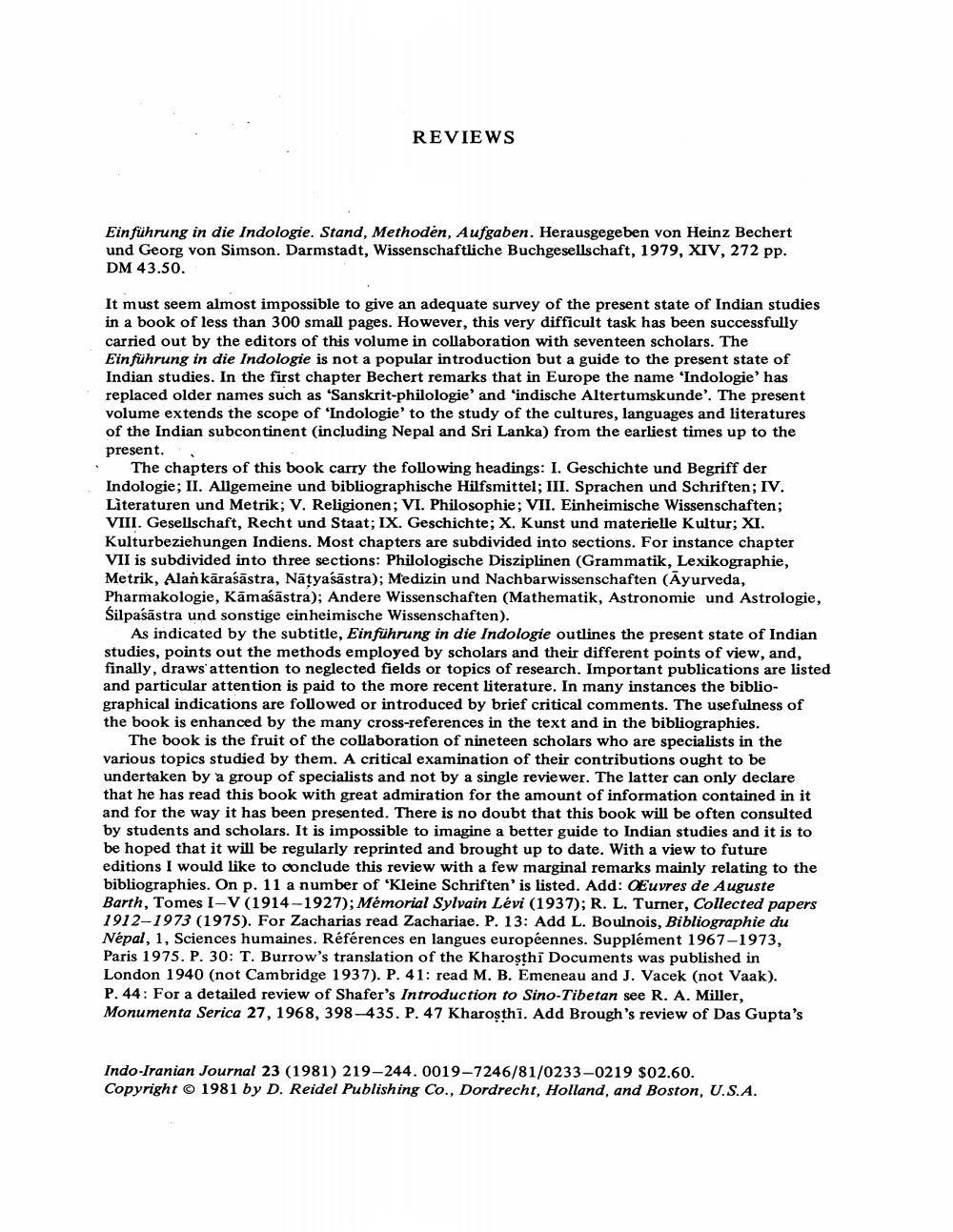Book Title: Book Reviews Author(s): J W De Jong Publisher: J W De Jong View full book textPage 1
________________ REVIEWS Einführung in die Indologie. Stand, Methoden, Aufgaben. Herausgegeben von Heinz Bechert und Georg von Simson. Darmstadt, Wissenschaftliche Buchgesellschaft, 1979, XIV, 272 pp. DM 43.50. It must seem almost impossible to give an adequate survey of the present state of Indian studies in a book of less than 300 small pages. However, this very difficult task has been successfully carried out by the editors of this volume in collaboration with seventeen scholars. The Einführung in die Indologie is not a popular introduction but a guide to the present state of Indian studies. In the first chapter Bechert remarks that in Europe the name 'Indologie' has replaced older names such as 'Sanskrit-philologie' and 'indische Altertumskunde'. The present volume extends the scope of 'Indologie' to the study of the cultures, languages and literatures of the Indian subcontinent (including Nepal and Sri Lanka) from the earliest times up to the present. The chapters of this book carry the following headings: I. Geschichte und Begriff der Indologie; II. Allgemeine und bibliographische Hilfsmittel; III. Sprachen und Schriften; IV. Literaturen und Metrik; V. Religionen; VI. Philosophie; VII. Einheimische Wissenschaften; VIII. Gesellschaft, Recht und Staat; IX. Geschichte; X. Kunst und materielle Kultur; XI. Kulturbeziehungen Indiens. Most chapters are subdivided into sections. For instance chapter VII is subdivided into three sections: Philologische Disziplinen (Grammatik, Lexikographie, Metrik, Alan kārasāstra, Natyasāstra); Medizin und Nachbarwissenschaften (Ayurveda, Pharmakologie, Kāmaśāstra); Andere Wissenschaften (Mathematik, Astronomie und Astrologie, Śilpasastra und sonstige einheimische Wissenschaften). As indicated by the subtitle, Einführung in die Indologie outlines the present state of Indian studies, points out the methods employed by scholars and their different points of view, and, finally, draws attention to neglected fields or topics of research. Important publications are listed and particular attention is paid to the more recent literature. In many instances the bibliographical indications are followed or introduced by brief critical comments. The usefulness of the book is enhanced by the many cross-references in the text and in the bibliographies. The book is the fruit of the collaboration of nineteen scholars who are specialists in the various topics studied by them. A critical examination of their contributions ought to be undertaken by a group of specialists and not by a single reviewer. The latter can only declare that he has read this book with great admiration for the amount of information contained in it and for the way it has been presented. There is no doubt that this book will be often consulted by students and scholars. It is impossible to imagine a better guide to Indian studies and it is to be hoped that it will be regularly reprinted and brought up to date. With a view to future editions I would like to conclude this review with a few marginal remarks mainly relating to the bibliographies. On p. 11 a number of 'Kleine Schriften' is listed. Add: OEuvres de Auguste Barth, Tomes I-V (1914-1927); Mémorial Sylvain Lévi (1937); R. L. Turner, Collected papers 1912-1973 (1975). For Zacharias read Zachariae. P. 13: Add L. Boulnois, Bibliographie du Népal, 1, Sciences humaines. Références en langues européennes. Supplément 1967-1973, Paris 1975. P. 30: T. Burrow's translation of the Kharoṣṭhi Documents was published in London 1940 (not Cambridge 1937). P. 41: read M. B. Emeneau and J. Vacek (not Vaak). P. 44: For a detailed review of Shafer's Introduction to Sino-Tibetan see R. A. Miller, Monumenta Serica 27, 1968, 398-435. P. 47 Kharoṣthi. Add Brough's review of Das Gupta's Indo-Iranian Journal 23 (1981) 219-244. 0019-7246/81/0233-0219 $02.60. Copyright © 1981 by D. Reidel Publishing Co., Dordrecht, Holland, and Boston, U.S.A.Page Navigation
1 2 3 4 5 6 7 8 9 10 11 12 ... 26
